Views: 0 Author: YILE Publish Time: 2025-06-24 Origin: https://www.yilemachinery.com/

In mining excavators, the coupling is a crucial component that connects the two shafts in the transmission system. Its main functions are as follows:


Flexible Shaft Coupling Flexible Shaft Coupling Half Coupling
Couplings transfer the power from the engine or motor to the transmission components of the excavator (such as the gearbox, hydraulic pump, etc.), ensuring efficient mechanical energy transmission and driving the equipment to operate.
In heavy-duty operations such as excavation and loading, couplings need to withstand high torque and shock loads, and their strength design is directly related to the reliability of the equipment.
Alignment compensation: Due to manufacturing, installation errors or working vibrations, there may be radial, axial or angular deviations between the drive shafts. Couplings can flexibly compensate for these deviations, reducing the additional stress on the shafts and bearings.
Floating connection: For instance, elastic couplings absorb minor displacements through materials such as rubber and polyurethane, preventing wear caused by rigid connections.
The working environment in mines is harsh, and equipment often undergoes severe vibration and shock. Elastic couplings (such as tire type and spring blade type) can absorb vibration and protect other components of the transmission system (such as gears and bearings) from damage.
Reduce noise and improve operational comfort.
Some couplings (such as safety couplings) protect critical components by disengaging or slipping (such as friction plate type) when the torque is overloaded, preventing the motor or transmission system from being damaged due to locked rotor.
Mining excavators may encounter environments with high temperatures, dust, and humidity. The materials of couplings (such as stainless steel and high-strength alloys) and their sealing designs must be corrosion-resistant and dust-proof to ensure long-term stable operation.
Gear coupling: High torque transmission, allows for certain deviations, used in heavy machinery.
Universal coupling: Provides multi-angle compensation, suitable for articulated excavators.
Elastic coupling: Excellent vibration damping performance, used for connecting motors and pumps.
Hydraulic coupling: Soft start, overload protection, suitable for high-power transmission.
Therefore, in mining excavators, the coupling is not merely a simple connecting component; rather, it is an essential component that ensures smooth power transmission, extends the equipment's lifespan, and enhances safety. The selection of the coupling requires comprehensive consideration of torque, rotational speed, deviation compensation capability, and environmental adaptability.
